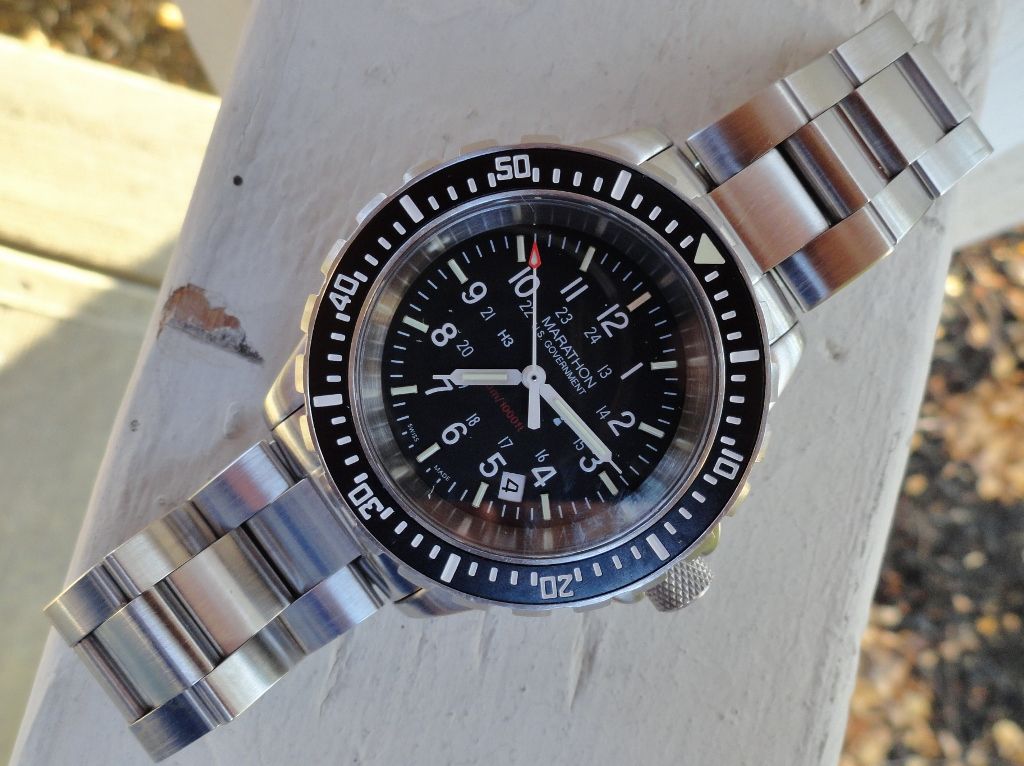Monday, October 7, 2013
Watch Review: Marathon TSAR on U.S. Great Seal Bracelet
Spend enough time on any of the usual watch forums - especially where dive watches are discussed - and sooner or later you'll come across the Marathon Search-and-Rescue series of watches. Marathon is a Canadian company that supplies Swiss-made watches to the U.S. and Canadian governments, and which has garnered a reputation for solid, purpose-built tool watches for those who value function first, form second. As previous mainstay tool watches like the Rolex Submariner and the Omega Seamaster venture farther into fashion - some might say "bling" - territory, the backlash against that trend has led some dive watch enthusiasts to seek out the classic tool watch functionality and aesthetic from other sources.
Marathon's SAR series comes in several flavors. The TSAR is a quartz-powered watch with a sensible 41mm diameter. The GSAR is its automatic-powered - by an ETA 2824, specifically - doppelganger. The JSAR is an oversized version at 47mm. And the CSAR tops out the line as the automatic Valjoux 7750-powered chronograph.
Given the playing field, my choice among Marathon's offerings was an easy one. The TSAR combines the ruggedness of an ideal dive watch with the better (though not impervious) shock resistance and low maintenance of a quartz movement. Despite its chunkiness, its 41mm diameter is very restrained in a world of 45mm+ monstrosities. The TSAR is only available on a rubber strap that - like most "regular" length straps on the market today - proved too long for its innermost hole to accommodate a 6" wrist. Even had the strap fit, though, I still would have opted to replace it with the very solid matching bracelet that Marathon offers emblazoned with either the U.S. great seal, a U.S. Marines seal, or the Canadian maple leaf. Given that the TSAR version I picked up features the "U.S. Government" notation usually found on government contract Marathons, I figured the U.S. great seal bracelet would provide a nice counterbalance and round out the tool watch aesthetic of the TSAR.
The TSAR maintains all of the tool watch features that other formerly function-over-form watch models have shed in the pursuit of fashion: drilled lug holes, a knurled crown, and a diver's bezel that is legible and functional from the full zero to 60 minutes. The minute hand is just long enough to line up with the minute indices, and the tritium illumination is bright but not obnoxiously so under darkened conditions.
For me, the Achilles' heel of a quartz movement is how the sudden need for a battery replacement can leave you with a dead watch at the most inconvenient times. The movement employed by the TSAR is one of several I've come across that fends off this contingency by including an end-of-life indicator that, in theory, should cause the movement to advance in 4-second increments when the battery needs changing. With that mechanism, maintenance of the watch becomes a far easier and predictable proposition than another dime-a-dozen quartz or even a mechanical movement.
Shopping around for the greatest deal available at the time, I snagged the TSAR and its bracelet for $707 all together. You might be able to find it for less depending on market conditions at the time, or if you are willing to go used and come across a solid example. How ever you get your hands on it, I highly recommend it.
Labels:
Bracelets,
Dive Watchees,
Marathon,
TSAR,
Watch Review
Subscribe to:
Post Comments (Atom)



No comments:
Post a Comment